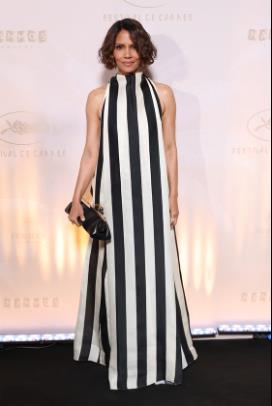Amal Clooney in Dior – (Image credit: Vogue.com)
For two weeks in May, global visionaries of cinema assembled in France for the annual Cannes Film Festival. With vibrant seas of red carpeting, the celebrities sailed forth amidst the cannon fire of paparazzi. Gathered to attend the premiere of each film submitted to the festival, the stars and filmmakers alike dressed for the chic elegance of France’s late spring setting.
But this year was different. A day before it began, the festival issued an official dress code that banned nudity for “decency reasons” along with voluminous gowns and lengthy trains. This meant that the meticulously planned attire of attendees could be reason for expulsion if deemed “indecent” for the festival.

Margaret Qualley in Chanel – (Image credit: Daniele Venturelli for GlamourMagazine.com)
In fact, Cannes is infamous for its strict enforcement of past dress codes. For example, in 2015, the festival received backlash when several women were turned away from a screening due to their flat shoes. While the organizers responded by stating that no official ban had been placed on flat footwear, the restriction was perceived as an unwritten rule of the festival and thus, enforced as security saw fit. In the following years, flats—and even bare feet—became common accessories to quietly protest the over-restriction of feminine attendees. While it began as explicit statements against the dress code, with Julia Roberts pairing her stunning black gown with no shoes in 2016, the unheeled accessories seeped into the cultural dialogue as a staple of the festival’s acceptable footwear. Margaret Qualley’s Chanel look this year embodies the chic nonchalance of flat shoes. In a wispy nude empire-waist gown, Qualley strutted up the Palais steps elegantly and comfortably.

Halle Berry in Jacquemus – (Image credit: Daniele Venturelli for Today.com)
With this year’s dress code announced so close to the premiere—only 24 hours before—it left many attendees questioning the permittance of their planned looks. Halle Berry, a member of the Main Competition’s jury, mentioned in a panel a last-minute change to her ensemble for the opening ceremony. Her original Gaurav Gupta gown was extravagant, sumptuous, and now feared to be prohibited for its lengthy train. Berry substituted the planned gown with a more understated Jacquemus Spring/Summer 2025 dress. Sporting simplicity and sleekness within the black and white striped ensemble, her fears could be relented in the look’s accordance to code.

Heidi Klum in Elie Saab – (Image credit: @heidiklum on Instagram)
However, the restrictions on dress length seemed to go unenforced for a majority of the festival, granting entry to all attendees, regardless of how grandiose a train. Notably, Heidi Klum’s dress of bundled flower petals was resplendent and immense, requiring a team to arrange the train for photographs and accommodations while sitting for the film premieres. There seems to be a question as to what extent one considers a specific dress to hinder the intended flow of carpet traffic. With the dress code rather vague in its technical guidelines, those tasked with overseeing the entry of festival-goers were given a shell of a rule, left uncertain of what concretely classifies a defiance of the code.
Granted almost no time for necessary changes to outfits not adhering to restrictions, the untimely announcement feels hastened and unplanned—a last-minute attack on gowns in attendance. On another plane, the masculine festival-goers exist free from the pelting stones of constant physical regulation, though perhaps fall regulated beneath the umbrella of unwritten codes of decorum.
While the Cannes Festival institutes these guidelines to encourage propriety at the events, past rules—such as “no flat shoes”—and those of this year can be construed as rather hypocritical. The dress code seems out of place for an event historically recognized to platform the avant-garde and outsider voices of cinema. What defines the so-called “indecency” of their restrictions? Does it only exist in the feminine form? The festival calls for the demureness of dress in combination with the artistic revolution and self-proclaimed freedom of its cinema screenings.
So why?
-------------------------------------
By: Annabella Lawlor
Title: Cannes 2025 – Classic, Elegant & CONSTRICTED
Sourced From: www.universityoffashion.com/blog/cannes-2025-classic-elegant-constricted/
Published Date: Sun, 22 Jun 2025 01:00:22 +0000
Read More
 FestivalsMusicNew ReleasesArtistsFashion & ClothingVideosPrivacy PolicyTerms And Conditions
FestivalsMusicNew ReleasesArtistsFashion & ClothingVideosPrivacy PolicyTerms And Conditions
